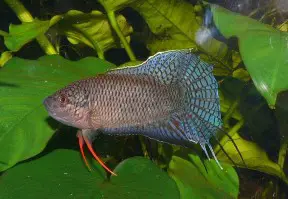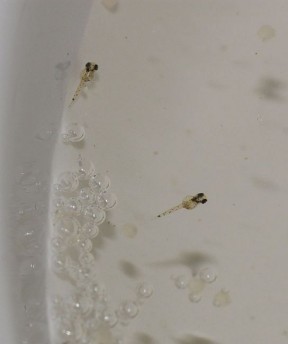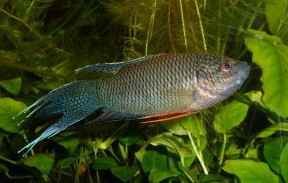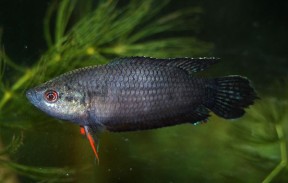Macropodus spechti
Black Paradise Fish
SynonymsTop ↑
Macropodus opercularis var. spechti Schreitmüller, 1936; Macropodus opercularis concolor Schreitmüller, 1936; ? Macropodus tramiensis Nguyen [H. D.] & Nguyen [V. H.], in Nguyen [V. H.] & Nguyen [H. D.], 2004; ? Macropodus yeni Nguyen [H. D.] & Nguyen [V. H.], in Nguyen [V. H.] & Nguyen [H. D.], 2004; ? Macropodus nigrocorpus Nguyen [H. D.] & Nguyen [V. H.], in Nguyen [V. H.] & Nguyen [H. D.], 2004
Etymology
Macropodus: from the Ancient Greek μακρός (makrós), meaning ‘long’, and ποδός (podós), meaning ‘foot, leg’, in reference to the long pelvic fins in members of the genus.
spechti: named in honour of P. Specht, a German aquarist based in the French port town of Le Havre who received the first material and donated specimens to E. Ahl, W. Schreitmüller (who subsequently described the species), and the British Museum of Natural History.
Classification
Order: Perciformes Family: Osphronemidae
Distribution
Known with certainty from the Thu Bồn River system in Quảng Nam province, and the Hương (aka Perfume) River basin in Thừa Thiên-Huế province, central Vietnam.
Type locality is erroneously given as ‘Dutch Indies [Indonesia]’.
Habitat
Has been collected from irrigation ditches, rice paddies, pools, marshes, hill streams, and backwaters of larger rivers.
Maximum Standard Length
70 – 80 mm.
Aquarium SizeTop ↑
An aquarium with base dimensions measuring 80 ∗ 30 cm or equivalent should be the minimum considered for a single pair.
Maintenance
Can be maintained in a fully-decorated aquarium although many breeders prefer not to use a substrate for ease of maintenance.
Driftwood roots and branches can be used and placed such a way that a few shady spots are formed, while some floating or surface vegetation should be included if the aim is to breed the fish (see ‘Reproduction’).
The addition of dried leaf litter further emphasises the natural feel and as well as offering additional cover brings with it development of microbe colonies which can provide a valuable early food source for fry.
Water Conditions
Temperature: 20 – 30 °C
pH: 6.0 – 8.0
Hardness: 90 – 357 ppm
Diet
Likely to prey on insect larvae and suchlike in nature, and should be offered small live or frozen Daphnia, Artemia, white worm, grindal worm, etc., in captivity. Some high quality dried products may also be accepted.
Behaviour and CompatibilityTop ↑
This species is relatively peaceful unless breeding. It can be maintained in a pair or group and will display some interesting behavioural interactions under the latter circumstances.
Sexual Dimorphism
Males are larger than females and possess extended soft rays in the dorsal, anal, and caudal fins.
Reproduction
Bubble nester. Soft water with a slightly raised temperature is said to induce reproductive behaviour.
The aquarium should have the tightest-fitting cover possible (some breeders use clingfilm/plastic wrap) because the fry need access to a layer of warm, humid air, without which development of the labyrinth organ can be impaired.
The pair need not be separated prior to spawning. The male tends to construct his nest within a raft of surface vegetation, and the female(s) are usually tolerated during this period. Once the nest is complete, the male displays to potential mates using his elongated dorsal, anal, and caudal fins.
The nuptial female becomes paler in colour. Spawning normally occurs beneath the nest in an ’embrace’ typical of osphronemids, with the male wrapped around the female.
At the point of climax milt and a few eggs are released. The latter contain a globule of oil and are lighter than water, therefore they float upwards to the nest, often assisted by the male. The process is then repeated until the female is spent, with several hundred eggs typically deposited.
Post-spawning the adults can normally be left in situ. The female is normally tolerated by the male and may even play an active role in defending the area around the nest from intruders.
Once the eggs hatch they remain in the nest until the yolk sac is fully-absorbed. When the fry begin to swim freely the male will lose interest, but the adults do not usually eat their offspring.
The require an infusoria-grade food for the first few days, after which they can accept motile foods such as microworm and Artemia nauplii. Water changes should be small and regular rather than large and intermittent.
NotesTop ↑
M. spechti is also sometimes referred to as M. concolor, particularly in older literature. A dispute regarding conservation of that name was resolved by the ICZN in 2006, however, since M. concolor Ahl, 1937 is a junior primary homonym of M. concolor Schreitmüller, 1936 and thus permanently invalid.
M. spechti can be distinguished from congeners by the following combination of characters: caudal-fin forked; opercular spot pale or absent; body lacking dark bars, or with 4-12 faint and inconspicuous dark bars on pale brown to dark greyish background; dorsal surface of head and predorsum without dark spots or saddle-like blotches; posterior tip or margin of scales on head and body conspicuously darker than scales; distal portion of anterior soft pelvic-fin ray red; spots and bars on dorsal and caudal-fin membranes black; posterior dorsal-fin membranes and caudal-fin membranes blue; filamentous caudal-fin rays with white or black posterior extremity; no red pigmentation in the unpaired fins.
Its name is frequently misapplied to the similar-looking congener M. erythropterus Freyhof & Herder 2002, which is easily-identified by the presence of reddish pigmentation in the dorsal, anal, and caudal fins. There has been some debate as to whether these two represent the same taxon, however, with Winstanley and Clements (2008) proposing that M. erythropterus be considered a synonym of M. spechti because they were unable to separate the two species by morphological characters, and specimens with red pigmentation on the unpaired fins were collected within the distributional range of M. spechti during the course of their study. This was rejected by Herder et al. (2010), who argued that Winstanley and Clements did not use material from the type locality of M. erythropterus, and that their study used a limited number of mainly juvenile specimens from only a part of the species’ known distribution. Both species are thus considered valid at the present time, with Kottelat (2013) remarking that additional study is necessary to determine whether they represent distinct taxa or not.
Like others in the suborder Anabantoidei this species possesses an accessory breathing organ known as the labyrinth, which permits the fish to breathe atmospheric air to a certain extent. Comprising paired suprabranchial organs formed via expansion of the epibranchial (upper) section of the first gill arch and housed in a chamber above the gills, it contains many highly-vascularised, folded flaps of skin which function as a large respiratory surface. Its structure varies in complexity between species, tending to be more developed in those inhabiting harsher environments.
References
- Schreitmüller, W., 1936 - Das Aquarium: die Fachzeitschrift des Naturfreundes, Berlin v. 10: 181-182
Ein neuer Makropode (?). Macropodus opercularis L. var. spechti Schreitm. (1936), (Netz- oder Gitterparadiesfisch). - Ahl, E., 1937 - Zoologischer Anzeiger 117(5/6): 113-119
Neue Süßwasserfische aus dem Indischen und Malaiischen Gebiet. - Endruweit, M. , 2014 - Zoological Research 35(2): 142-159
Taxonomical notes on selected freshwater fish species described from northern and central Vietnam (Cypriniformes: Balitoridae, Cobitidae, Cyprinidae, Nemacheilidae; Perciformes: Channidae, Osphronemidae; Synbranchiformes: Mastacembelidae). - Freyhof, J. and F. Herder , 2002 - Ichthyological Exploration of Freshwaters 13(2): 147-167
Review of the paradise fishes of the genus Macropodus in Vietnam, with description of two new species from Vietnam and southern China (Perciformes: Osphronemidae). - Herder, F., J. Huykebrouck and K. Busse, 2010 - Bonn Zoological Bulletin 59: 109-136
Catalogue of type specimens of fishes in the Zoologisches Forschungsmuseum Alexander Koenig, Bonn. - ICZN, 2006 - Bulletin of Zoological Nomenclature 63(1): 78-79
Macropodus spechti Schreitmüller, 1936 (Osteichthyes, Perciformes): priority maintained. - Kottelat, M., 2013 - Raffles Bulletin of Zoology Supplement 27: 1-663
The fishes of the inland waters of southeast Asia: a catalogue and core bibiography of the fishes known to occur in freshwaters, mangroves and estuaries. - Kottelat, M., S. O. Kullander, F. Fang and R. Britz, 2004 - Bulletin of Zoological Nomenclature 61(2): 114-116
Comment on the proposed conservation of the specific name of Macropodus concolor Ahl, 1937 (Osteichthyes, Osphronemidae). - Paepke, H-J., 1994 - Neue Brehm Bücherei 616, Westarp Wissenschaften, Magdeburg: 1-144
Die Paradiesfische. - Schindler, I., 2009 - Der Makropode 31(1): 9-12
News on the taxonomy and distribution of Macropodus species. - Schindler, I. and W. Staeck, 2003 - Bulletin of Zoological Nomenclature 60(3): 206-207
Macropodus concolor Ahl, 1937 (Osteichthyes, Perciformes): proposed conservation of the specific name. - Winstanley, T. and K. D. Clements, 2008 - Zootaxa 1908: 1-27
Morphological re-examination and taxonomy of the genus Macropodus (Perciformes: Osphronemidae).







